Inside this Article


Save up to 19.2 % on your AWeber plan!
Limited-time offer - Don't miss it!
109 users used this coupon!
Features
AWeber Offers More than Just the Basics
When you compare AWeber vs. ConvertKit, one of the starkest differences is the number of email templates. AWeber offers more than 700 email templates, while ConvertKit has only 9. No, I’m not missing any zeroes there.

Ease of Use
ConvertKit Is Messy and Confusing
Almost all EMS let you design an email in the same way. You click create, fill out a few details, choose a template, and get to editing. Simple. These platforms work this way because we’re all familiar with it. Except for ConvertKit, that is. To design an email in ConvertKit, you have to use two different editors – one to create the template and edit fonts, and one to add images and write your content. Honestly, I have no idea why it’s so convoluted.
Deliverability
Average Deliverability on Both Counts
Look, I wish I could wrap up deliverability in a tidy little percentage, but I’m not here to lie to you. Deliverability tests are pretty unreliable, so I don’t use them. There are just far too many variables for a percentage rate to be meaningful. Every email provider treats incoming emails differently, and the time of day, infrastructure, server locations, and thousands of other things will always influence whether an email reaches a subscriber’s inbox or their spam folder. Now, I’m not saying that every time you send an email, the Internet Gods toss a coin to figure out where to send it. There are some proven ways to improve your deliverability – you just can’t represent them as a percentage rate.
AWeber
and ConvertKit also both allow affiliate marketing on their servers. That’s not all that surprising for ConvertKit, since affiliate marketing can be a lucrative income stream for online creators. However, it’s worth bearing this in mind because affiliate marketing emails can have a higher than average spam complaint rate.
With AWeber, contacts have to consent to receive affiliate emails, and those affiliate programs can’t flout AWeber’s guidelines. Seriously, that’s it. ConvertKit is much stricter. It has restrictions on which affiliate programs are allowed, and you have to have a business outside of affiliate marketing. The majority of your content also can’t consist of affiliate marketing content.
Something else to consider is that access to a dedicated IP can make all the difference with deliverability. When you share a server with thousands of other businesses sending emails, the whole server can be blacklisted if just one person is caught using that server for spam.
AWeber doesn’t offer dedicated IP addresses, but ConvertKit does. I can’t say I’d recommend paying for a dedicated IP address with ConvertKit given my experience testing this EMS, but at least it offers this service for anyone who sends more than 150,000 emails a week.
Otherwise, AWeber and ConvertKit both have similar spam policies. Both of these platforms will terminate your account as soon as they catch you sending spam. Overall, I’d say ConvertKit wins this round, but neither EMS is anything but average when it comes to deliverability.
Reporting and Analytics
If You Want Actionable Insights, AWeber’s Got You Covered
No matter whether you’re a beginner or an experienced email marketer, numbers are your best friend. This is, unfortunately, another area where ConvertKit let me down, and, to be honest, the reporting and analytics was one of the key areas that disappointed us in our ConvertKit review. To begin with, it’s really hard just to find ConvertKit’s reporting dashboard. Yep, the usability issues with ConvertKit don’t end with the weird template/email editors situation. If you want to see any analytics, you either need to click onto the Subscribers page or click into each individual email. You can’t see an overview of your campaigns (or broadcasts, as ConvertKit calls them) at all. Even once you’ve found these stats, all you’ll get is some basic information on how many subscribers you have, plus how many of them received each email, opened it, clicked links, and unsubscribed. That’s it. By comparison, AWeber has an easy-to-read analytics dashboard that’s recently been revamped. On top of the basic open, click, and subscription rate, you’ll also be able to see metrics like your sales over time and subscribers by location, both of which can help you plan future campaigns, and they’re available on the AWeber free plan. If you upgrade, you get even more statistics.
Pricing
AWeber Offers Far More for Your Money
AWeber and ConvertKit both offer free limited plans, but the main difference between these two EMS platforms comes with their paid tiers. If you find AWeber’s free plan too limited, then you can upgrade to AWeber Pro to access the whole suite of features. Like most other EMS, this costs more the more subscribers you have, but there are no features hidden behind different paid tiers. By comparison, ConvertKit offers two paid plans – Creator and Creator Pro. This is charged by the number of subscribers you have, but it starts at 300 instead of 500.Here’s What You Get for Free
ConvertKit’s free forever plan includes unlimited emails for up to 1,000 subscribers. You also get unlimited landing pages, the ability to sell digital products, and a digital tip jar. If you need help, you can ask the community forum or message the platform team through Intercom.AWeber
allows you to send up to 3,000 emails a month with a subscriber list cap of 500 contacts. While you won’t get a digital tip jar, you will get a ton more features than ConvertKit offers, like 700+ email templates, far more comprehensive analytics, and sales tracking.
Here’s What You Get If You Pay
ConvertKit has two paid plans. You get slightly more than you do on the free plan if you pay for ConvertKit’s Creator plan, as this opens up live chat and email support, automated funnels, and 70+ integrations with platforms like Patreon, Teachable, and Zapier. ConvertKit’s Creator Pro plan has the features you’ll probably find the most useful, like subscriber engagement scoring, advanced reporting, and priority support. However, I can’t say I recommend paying for ConvertKit based on how lackluster its features are. You can get far more for your money elsewhere. AWeber’s Pro plan is pretty comprehensive, and it’s refreshing to see an EMS that only uses one payment tier. It makes my job as a reviewer a lot easier, so it’ll definitely simplify things for you as an email marketer too. AWeber Pro offers all the features you’d expect – like advanced analytics, custom segmentation, and automation – and it removes the cap on how many emails you can send each month. You can even split-test sign-up forms with AWeber Pro, which is a nice addition. Here’s a quick breakdown of ConvertKit vs. AWeber pricing:ConvertKit Creator
AWeber Pro
Starting Price
$29.00
$12.50
Contact limit*
500,000
25,000
Email limit
Unlimited
Unlimited
Email templates
9
700+
Integrations
70+
1,000+
A/B Testing
Subject lines only
All email elements and can test up to three variants
Transaction fees
3.5% + 30c
0.6%
Support
ConvertKit’s Promptness Surprised Me
Given my experiences with ConvertKit so far, I was pleasantly surprised by the support options available, even on the free plan. The ConvertKit free plan offers live chat and access to the Creator Community, which is essentially a social media-style help forum. Strangely, ConvertKit doesn’t advertise that the free plan has a live chat support option.

ConvertKit vs. AWeber: Creator-Focused Doesn’t Equal Good
Overall, AWeber’s got a lot more to offer than ConvertKit. AWeber has a great free plan that focuses on quality communications, and it’s a lot easier to find your way around. I also found AWeber’s feature suite was a lot more comprehensive. Seriously, 700+ email templates compared to ConvertKit’s 9 isn’t even a competition. Even though a good number of those templates are pretty dated, you’ve still got hundreds more to play with. Whether you’re a content creator or simply seeking a cost-effective alternative to the major EMS platforms, I recommend avoiding ConvertKit personally. AWeber provides a greater value for your investment, and it’s less likely to lead to frustration during your journey.ConvertKit
AWeber
Templates
9
700+
Automation
Multi-step automation with templates and an “if/then” single-step automation builder
Multi-step automation builder with templates, behavioral automation, transactional emails
Native SMS Automation
No – has to be connected via integrations
No – has to be connected via integrations
Apps and Integrations
70+
100+
Landing Page Builder
Yes, with 50+ templates and unlimited landing pages
Yes, with 40+ templates and unlimited landing pages
A/B Testing
Yes, subject lines only
Yes, testing for all email elements for up to three variants, plus A/B testing for sign up forms
Native RTL Language Support
No
Yes
Ease of Use
Confusing interface with more editors than it needs
Clearly laid out and simple to navigate
Deliverability
Average deliverability, dedicated IP addresses available for high-volume senders, but affiliate marketing is allowed
Average deliverability, but affiliate marketing is allowed
Reporting and Analytics
Extremely basic with no single analytics dashboard
Fairly detailed with report filtering and the ability to download reports as a CSV
Pricing
Free limited plan, paid plans start at $29.00
Free limited plan, paid plans start at $12.50
Support
Creator Community, knowledge base, and live chat, with 24/7 live chat/email, and priority support available on paid plans
Knowledge base, video tutorials, 24/7 live chat, email, and phone support on all plans
Total
2
4


![ActiveCampaign vs ConvertKit: There’s Only One Option [2025]](https://dt2sdf0db8zob.cloudfront.net/wp-content/uploads/2022/01/Sendinblue-vs-Mailchimp-850x435.jpg)
![ActiveCampaign vs ConvertKit: There’s Only One Option [2025]](https://dt2sdf0db8zob.cloudfront.net/wp-content/uploads/2021/06/Alexandros-Melidoniotis-Writer-and-Editor-at-Website-Planet-150x150.png)

![10 Best Email Marketing Software for Ecommerce [2025 Update]](https://dt2sdf0db8zob.cloudfront.net/wp-content/uploads/2023/08/Best-Email-Marketing-Software-for-Ecommerce-850x446.jpg)
![Keap vs Mailchimp: Which Offers Better Value? [2025 Update]](https://dt2sdf0db8zob.cloudfront.net/wp-content/uploads/2023/06/Keap-vs-Mailchimp-850x446.jpg)

![Drip vs Mailchimp: Read Our Advice Before You Sign Up [2025]](https://dt2sdf0db8zob.cloudfront.net/wp-content/uploads/2022/10/Vs-1-850x446.jpg)
![Drip vs Mailchimp: Read Our Advice Before You Sign Up [2025]](https://dt2sdf0db8zob.cloudfront.net/wp-content/uploads/2022/08/Emily-Robin.jpg)
![MailerLite vs ConvertKit: Read This Before You Sign Up [2025]](https://dt2sdf0db8zob.cloudfront.net/wp-content/uploads/2022/10/Vs-850x446.jpg)




